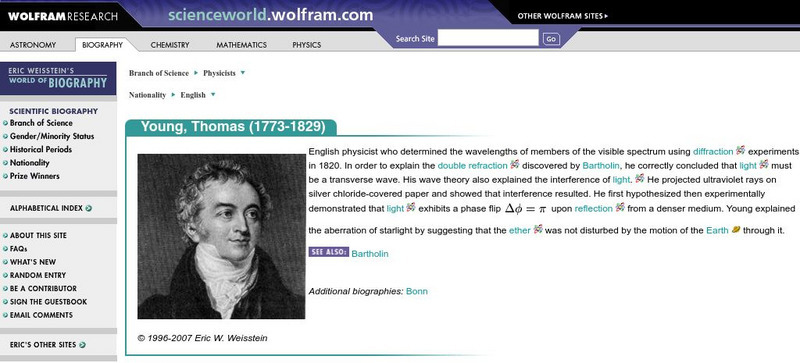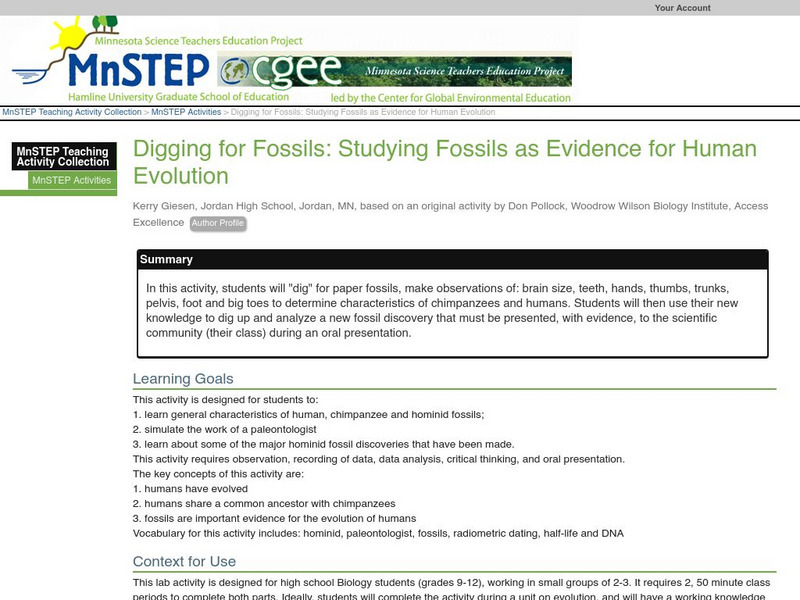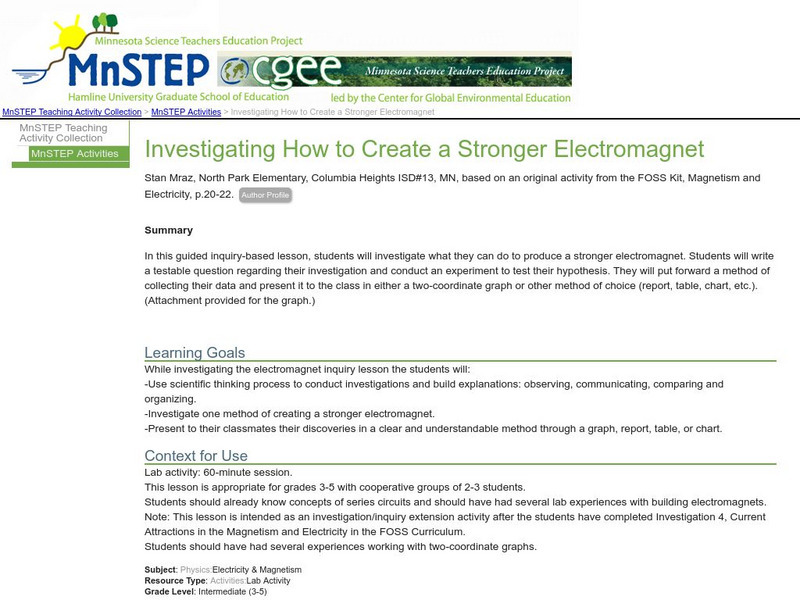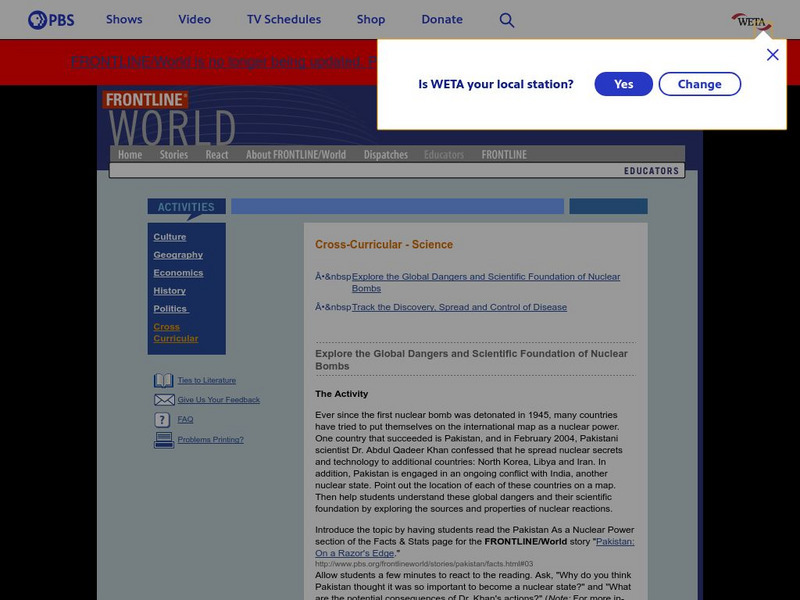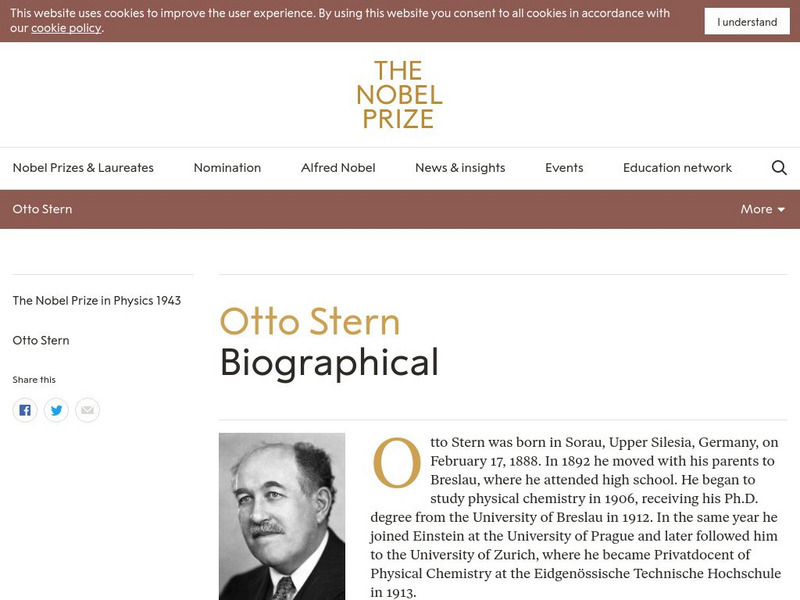Wolfram Research
Wolfram Science World: Young, Thomas
This site from ScienceWorld provides a very short but factual biographical sketch of Thomas Young (1773-1829 CE) and describes his most notable scientific discoveries and contributions. Links are also provided throughout for additional...
Wolfram Research
Wolfram Science World: Snell, Willebrord
This site from ScienceWorld provides a very short biographical sketch of Willebrord Snell (1591-1626 CE) and describes his most notable scientific discovery, the law of refraction. Links are provided for additional information as well.
Wolfram Research
Wolfram Science World: Roemer, Olaf
This ScienceWorld site provides a biographical sketch of Olaf Roemer and describes his most notable scientific discoveries such as the first good estimate of the speed of light.
Wolfram Research
Wolfram Science World: Rontgen, Wilhelm
This site from ScienceWorld provides a very short biographical sketch of Wilhelm Rontgen (1845-1923 CE) and describes his most notable scientific discoveries and contributions.
Curated OER
Science World: Michelson, Albert
This ScienceWorld site provides a short biographical sketch of Albert Michelson and describes his most notable scientific discoveries and contributions. Several links are provided for additional information as well.
Curated OER
Science World: Huygens, Christiaan
This ScienceWorld site provides a short biographical sketch of Christiaan Huygens and describes his most notable scientific discoveries and contributions. Links are provided throughout for additional information as well.
Curated OER
Science World: Young, Thomas
This site from ScienceWorld provides a very short but factual biographical sketch of Thomas Young (1773-1829 CE) and describes his most notable scientific discoveries and contributions. Links are also provided throughout for additional...
Curated OER
Science World: Fresnel, Augustin
This site from ScienceWorld provides a short biographical sketch of Augustin Fresnel (1788-1827 CE) and describes his most notable scientific discoveries and contributions. Links are provided throughout for additional information.
Curated OER
Science World: Snell, Willebrord
This site from ScienceWorld provides a very short biographical sketch of Willebrord Snell (1591-1626 CE) and describes his most notable scientific discovery, the law of refraction. Links are provided for additional information as well.
Curated OER
Science World: Rontgen, Wilhelm
This site from ScienceWorld provides a very short biographical sketch of Wilhelm Rontgen (1845-1923 CE) and describes his most notable scientific discoveries and contributions.
Harvard University
Harvard Smithsonian: Everyday Classroom Tools
The focus of this series of lessons is to engage students in an exploration of the world around them. The emphasis is on inquiry as students learn about the earth, sun, light, shapes and more.
ACT360 Media
Act Den: Sky Den
This journey will help you solve big questions about the universe. You will be able to see beyond human capabilities and will learn what scientists are discovering.
South Carolina Educational Television
Know It All Media: Nasa Online
Find award-winning science, math and technology videos and interactives for grades K-12 produced by NASA and provided for distribution to South Carolina ETV's Knowitall.
Science Education Resource Center at Carleton College
Serc: Digging for Fossils: Studying Fossils as Evidence for Human Evolution
As students dig for paper fossils, they make observations of brain size, teeth, hands, thumbs, trunks, pelvis, foot and big toes to determine characteristics of chimpanzees and humans. Then, they dig up and analyze a new fossil...
Science Education Resource Center at Carleton College
Serc: Investigating How to Create a Stronger Electromagnet
In this lesson, students will investigate what they can do to produce a stronger electromagnet. Students will use the scientific thinking process to conduct investigations and build explanations. They will present their discoveries to...
TED Talks
Ted: Ted Ed: Rosalind Franklin: Dna's Unsung Hero
The discovery of the structure of DNA was one of the most important scientific achievements in human history. The now-famous double helix is almost synonymous with Watson and Crick, two of the scientists who won the Nobel prize for...
PBS
Pbs Teachers: Cross Curricular: Science
Explore global health issues by participating in research, discussions and presentations on topics such as exploring the dangers and scientific foundation of nuclear weapons and tracking the discovery, spread and control of disease.
Wikimedia
Wikipedia: Albert Einstein
In this Spanish-language entry, grasp a concrete understanding of a complicated man whose discoveries impacted society more than any other scientist. This site chronicles the life and accomplishments of Albert Einstein. It also studies...
Other
Saudi Aramco World: Rediscovering Arabic Science
For most westerners, and indeed for many Arabs, the spectacular achievements of Arabic language science from the eighth through the 16th centuries come as a startling discovery, as if an unknown continent had suddenly appeared on the...
Other
Illinois Wesleyan Univ.: Tardigrade Species Distribution Project: Lesson Plan
This lesson plan was for classes that participated in a research project on tardigrades that took place in 1999. Tardigrades, also known as water bears, are fascinating, tiny creatures that can survive under the most extreme conditions....
National High Magnetic Field Laboratory
Magnet Academy: Karl Alexander Muller
In their search for new superconductors, Swiss theoretical physicist Karl Alexander Muller and his young colleague, J. Georg Bednorz, abandoned the metal alloys typically used in superconductivity research in favor of a class of oxides...
Famous Scientists
Famous Scientists: J. J. Thomson
Learn about the life and scientific inventions and discoveries of J. J. Thomson.
Nobel Media AB
The Nobel Prize: Otto Stern Biographical
This is a brief biography on the life and scientific work of Otto Stern, a physicist honored with the Nobel Prize in physics for his "development of the molecular ray method and his discovery of the magnetic moment of the proton."
NOAA
Noaa: Ocean Explorer: Rms Titanic Expedition 2004
Dr. Robert Ballard returns to the Titanic after his famous discovery in the 1980s. Dr. Ballard and scientists from NOAA spent eleven days conducting scientific analyses of its deterioration. Three lesson plans are available that focus on...
